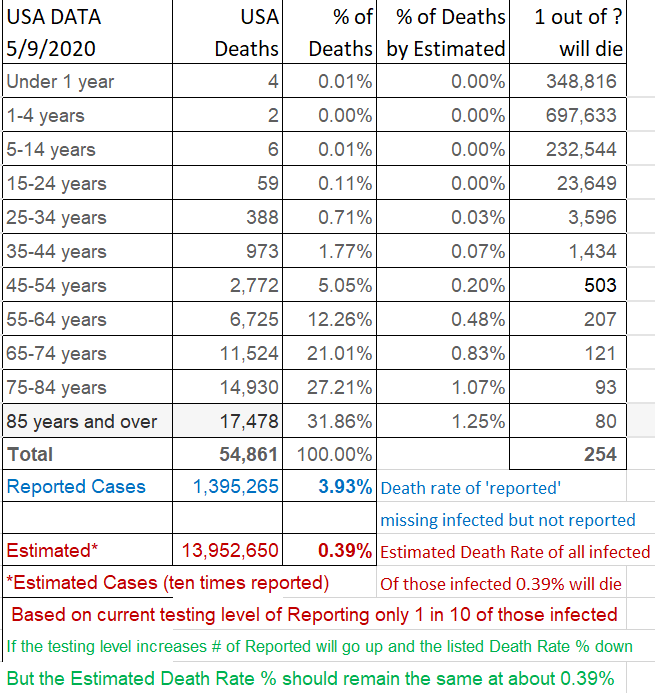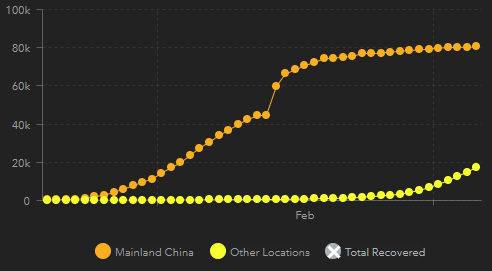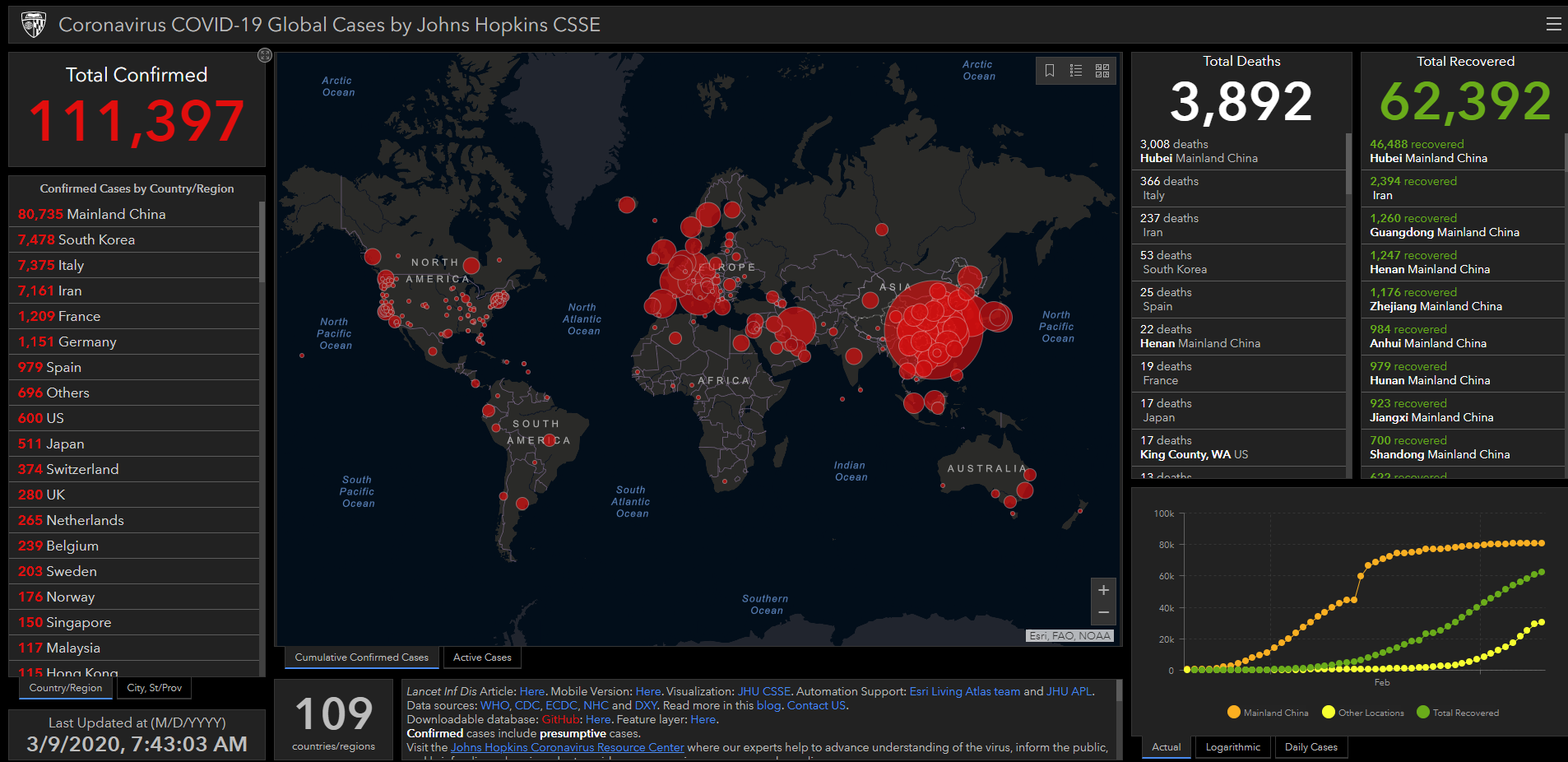Coronavirus
I got tired of all the misinformation about the COVID-19 Coronavirus outbreak so I made a list of facts on 3/3/2020. As many things have changed here now in April 2020, I haven't tried to update this information, although there still are many really good links, and most of the data still applies.I created this page to help educate people. Please get the facts before you say 'this isn't a big deal'. If you say "I don't understand why this is such a big deal", then please educate yourself. In doing my research, I took what I thought to be credible sources of information and compiled it here. This virus has in my opinion a likely potential to kill 38,000,000 people around the world. compared to about 500,000 deaths each year by the flu, this is a significantly larger number. In the United States it looks like it will be around 842,000 people dead. If you disagree with this, then I ask to read below and evaluate the full situation for yourself and I would love to discuss this with you.
May 14, 2020
We now have some good numbers on death rates and infections in the United States. The numbers in the media are confusing because they only give you part of the necessary information. For instance, in March 2020 the number of Confirmed cases reported was only those that were severely sick. As testing becomes more available, then these numbers start including less severe cases all the way to confirmed cases without any symptoms (asymptomatic). As the testing increases to include those mild or asymptomatic cases, then the multiplier used to estimate the total number of cases will go down. Unfortunately, not a single piece of news can stand by what the real likely number is including critical, severe, mild, and asymptomatic cases because the data is not there, and we are not applying our resources to figure this out at any scale. I think my assumption of a 10 times Confirmed is a good estimate on the 5/9/2020 data from the CDC.Death Rates by Age

Estimated Infections.
Of those infected, about 40% show NO SYMPTOMS, 40% show SLIGHT SYMPTOMS that won't be severe enough to require a doctors visit, about 15% are SEVERE and will have some form of pneumonia, and about 5% will be CRITICAL. You cannot be tested by choice, only if you are showing symptoms. I estimate for every test there are about 9 that haven't been tested that have the COVID-19 virus or now have antibodies for it.Probable United States Deaths
360,000,000 people. 60% infection rate before herd immunity severely slows propogation. 0.39% death rate.360,000,000 * .6 * .0039 = 842,400 likely deaths in the United States by COVID-19 in 2020-2021.
May 4, 2020
I haven't updated this for a while because there is so much information out there that anyone can learn as much as they want. Here are some of my observations:R-Number
This is one of the most important things to understand how viruses spread. If you don't understand this, then you are lacking a very important component of COVID-19. Here is theWikipedia page for this. In summary the R-Number is the amount of people that a person will transmit the virus to. If the R-Number is greater than 1, then the virus will keep propogating. In normal society, the R-Number for COVID-19 is between 2 and 4. For a R-Number of 2, that means on average, each person infected will give it to 2 more people. Those 2 people will give it to 2 people each, or 4 people. 4 to 8, 8 to 16, etc. If society changes its behavior to social distancing, then the number can be reduced, even to less than 1. If it becomes less than 1 then the virus COULD THEORETICALLY be stopped. Unfortunately if you change your behaviour back to normal, as long as a single person in society has this virus, then the R-Number goes back to 2-4 and it rapidly spreads once again. If you can contact trace, then you can chase this and try to stamp it out but it is very difficult. That is why a pandemic means that you CAN'T under normal circumstances stop this. Everytime society goes back to 'normal' the virus continues to spread. If we 'open up' it will keep spreading. If we stay closed our economy tanks. Tough decisions ahead.
Revised Death Count
It appears that the death rate COULD BE as low at 0.37% in the United States as opposed to the previous number of 2.3%. If so, then 330,000,000 people with a 60% total infected before herd immunity times 0.0037 = 732,600 deaths in the USA. If you are still sticking to 'this is just like the flu', then you are wrong. The flu kills 20,000 to 60,000 in the USA every year. This will kill 10 times that many people. If the death rate is higher than 0.37, adjust that number accordingly. It is super difficult to find the real number for this - the data is just not there even though it totally should be. This is applied science. If you disagree with this I would love for you to help enlighten me......., just make sure to bring the sources for your data.......
April 5, 2020
As of April 5, 2020 we have learned a lot about COVID-19. Moving forward I see 3 Options:OPTION #1: Flatten the Curve by Shelter In Place, staying home while some businesses stay open. This will cause 100,000s of deaths, and decimate the economy as many service sector jobs are closed during this time with millons of people out of work, probably creating a long recession. This is accomplished by social distancing (closing schools, large events, 6 feet distancing, staying at home, etc) which will keep the transmission rate in the United States possibly as low as 5% per day. This can slow the spread but not stop it. This continues on until a vaccine is created probably around March 2021, transforming our lives for the next 12 months and decimating our economy.
OPTION #2: Opening up the country up letting the virus spread unabated. The growth rate becomes exponential until about 70% of people get the virus. This will result in approximately 1,650,000 deaths in the United States, overwhelming the hospitals and inundating news and social media with the horrible stories of so many deaths over a relatively short period of time (about 12 weeks).
OPTION #3: Isolate the at risk people and purposely infect the less-at-risk people with the virus. The at-risk group here is defined as those over 60ish and anyone with underlying health conditions. Certainly anyone at any age can die from this, but the numbers are clear - it kills older people and people with underlying health conditions. Have groups of people purposely get the virus. This could be by taking someone with a fever and have them in very close proximity to others, or simply inject the virus into people. Isolate this group for about 6 weeks. How best to do this? College Dorms, Vacant Hotels, Isolation at Home without At-Risk people, etc - let's be creative here. Check to make sure they have fully recovered, and reintroduce them back into society. These people now both can't get sick, and can't transmit the virus to those at risk people. SOME SORT OF VARIATION OF THIS NEEDS TO HAPPEN, BECAUSE OPTION 1 AND OPTION 2 BOTH SUCK. This would require clarity, coordination, and courage, which I am not sure our society or government has at this point. If you say this isn't practical, then which option above do you choose? What alternatives do we have?
Useful Websites
Reference: Updates: Worldometers
Reference: CDC US CASES
Reference: Buzzfeed - US CASES
Reference: John Hopkins Map
Reference: CDC Map of Cases
California
Reference: LA Times - California Cases
Orange County
Reference: Orange County Cases
Flatten The Curve
Reference: https://www.flattenthecurve.com/
Sesonality
Will this be seasonal? While we don't know for sure, the consensus from experts is generally that it 'might' be slowed, but not significantly enough for the virus to dissappear, which will cause a second wave when things cool down again in fall.
Reference: CCDC Sesonality of COVID-19
Reference: BBC
Reference: Live Science
Social Distancing Math
Reference: Visual Capitalist - The Math Behind Social Distancing
KN95 Masks
KN95 Masks
Slowing Down the Spread
If a country puts in place practices such as Quarantine, Isolation, and Social Distancing, then this greatly slows down the spread of the virus. China's growth dropped significantly once this draconion measure was put in place. Japan also has been able to slow the rate of growth. In countries where the virus is just starting to expand at higher rates will have to consider puting these measures into practice. If not, then 500 will quickly become 1,000, 1,000 will quickly become 10,000, 10,000 will become 100,000 and so on. This happens faster than might be expected - it only takes 14 days to go up ten fold. If you doubt this, take out your calculator and just keep multiplying a number by 1.19 which represents a 19% growth each day (our current level of number of new cases each day early March 2020)
- Isolation is separating those with confirmed infections from other people, so that they can get better without infecting anyone else.
- Quarantine is restricting the movement of, or isolating, people who might have been exposed to an infection but who aren't yet sick.
- Social Distancing refers to a slew of tactics meant to keep people from congregating in large crowds, to slow the spread of a virus.
Reference: Vox 5 People from China, Iran, Italy, Singapore, and South Korea explain life in Isolation
Shortage of Hospital Beds
And, the calculations based on the C.D.C.'s scenarios suggested, 2.4 million to 21 million people in the U.S. could require hospitalization, potentially crushing the nation's medical system, which has only about 925,000 staffed hospital beds. Fewer than a tenth of those are for people who are critically ill.
Reference: New York Times
Severity Rate
The virus does not affect all people the same way. For the vast majority of people (81%) that catch the virus, they will hardly know they have it or it will just feel like a nagging cough with some flu symptoms. This is good news and bad news. The good news is obvious - it isn't a big deal for those people that fall in the 81%. The bad news is that for the other 19%, there is significant risk of dying. More bad news is that the virus can be spread from those with no symptoms or mild symptoms, enabling this virus to spread quickly throughout the world. Right now the numbers are low, but if it keeps spreading, these numbers become large pretty fast.
- 81% of cases were mild (42% had no symptoms at all)
- 14% of cases were severe (slight to moderate pnumonia)
- 5% of cases were critical (requiring hospital care)
Reference: The Scientist Why Some Cases are Worse than Others
Reference: Marketwatch Fatality Rates
How does this affect different Age Groups?
-
Infections by Age
- Ages 0 to 9 - 0.9%
- Ages 10 to 19 - 1.2%
- Ages 20 to 29 - 8.1%
- Ages 30 to 79 - 87%
- Ages 80 and above 3%
- Ages 10 to 39 - 0.2%
- Ages 40 to 49 - 0.4%
- Ages 50 to 59 - 1.3%
- Ages 60 to 69 - 3.6%
- Ages 70 to 79 - 8.0%
- Ages 80 and above - 14.8%
- 1.7% for women
- 2.8% for men
Mortality Rate by Age
Infections by Gender
Reference: Worldometer
China CDC's analysis of 44,672 patients found that the fatality rate in patients who reported no other health conditions was 0.9%. It was 10.5% for those with cardiovascular disease, 7.3% for those with diabetes, 6.3% for people with chronic respiratory diseases such as COPD, 6.0% for people with hypertension, and 5.6% for those with cancer.
Cases
US Cases
Reference: CDC US CASES
To see the cases in the world or a specific country or state, click here: Reference: John Hopkins Map
To see cases by US States, click the US on the left pane, then the City, St/Prov tab at the bottom left.
The World Health Organization also has a map: Reference: CDC Map of Cases
Cases on 3/5/2020

Symptoms
Common signs of infection include fever, cough and breathing difficulties. If the infection worsens, it can cause pneumonia, severe acute respiratory syndrome, kidney failure and death.
Symptoms may appear 2-14 days after exposure:
- Fever
- Cough
- Shortness of breath
Reference: Marketwatch Symptoms
Reference: YouTube Example Case
Contagiousness
Without controls transmission is estimated to be 1.6 to 4.5. This means each person that gets it gives it to 1.6 to 4.5 other people.
Reference: CNN How a Virus Spreads
Vaccine
A vaccine will take 1 to 1.5 years to develop, test, and distribute. Once a vaccine is available this problem mostly goes away. The issue is making it through the next 12 to 18 months. If the world is able so slow the spread of the virus, it will affect fewer people. Unabated, the virus will spread through the globe before we have a vaccine, killing millions of people.
History
We should look to our history to see if we can learn anything about what this virus might do.
Reference: YouTube Spanish Flu / Swine Flue 1918 Pandemic
Also research the most recent pandemic, the Swine Flu (H1N1) from 2009.
Comparison to the flu (influenza)
According to data from the United States Center For Disease Control (CDC) The flu typically has a mortality rate of between 1% and 2% depending on the circumstances in any given flu season. Data in the link below if for years 2010 and 2019. Annual flu vacccinations help to keep the total number of people that are infected much lower than would be the case without vaccinations.
Reference: CDC Influenza Disease Statistics
Predicted Deaths
Let's look at some facts and make some educated guesses based on the facts:
- The world population is 7,700,000,000 people.
- The virus will infect 50% of the population
- The mortality rate will be 1%
Here is the calculation: The number of deaths = 7,700,000,000 * .5 *.01
- The United States Population is 330,000,000 people.
- The virus will infect 50% of the population
- The mortality rate will be 1%
Reference: CDC. Is this just another flu? Not if 1.6 million people die in the United States instead of 60,000 people. This is likely to be over 27 times worse in number of deaths than the flu. That is why this is a big deal.
Where does the number of infected come from? Smart people that understand this stuff - Epedimiologists who are educated regarding viruses and such. These SCIENTISTS are predicting (not politicians or news folks, but Epedimiologists) rates of 60% and 70% infection rate.
Reference: Harvard Epidemiologist
Reference: Hong Kong Epedimiologist
Reference: YouTube Epedimiologist prediction


Reference:
Coronavirus Terms
Reference: CNN Coronavirus Terms
alanharmon.net